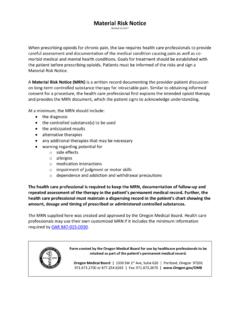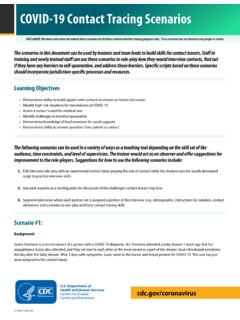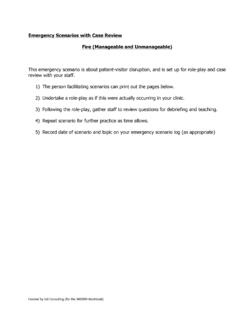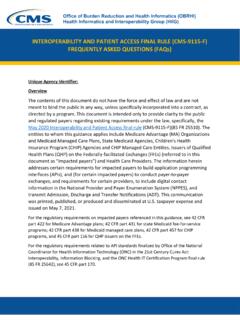Transcription of Planning for COVID-19 Scenarios in Schools - Oregon
1 Planning for COVID-19 Scenarios in Schools A Toolkit for School Leaders and Local Public Health Authorities Updated January 27, 2022. Any substantial changes in this version have been marked up in green italics to help track changes. The use of italics and a different color is for meeting accessibility requirements and does not signal any specific emphasis or importance. Introduction This resource was prepared by the Oregon Department of Education (ODE) and the Oregon Health Authority (OHA) with additional input from local public health authorities (LPHA), school nurses, and school leaders to support school staff's ability to respond well to COVID-19 related illness events. This document outlines some critical steps and offers an overview of decision points, but it does not replace medical expertise, epidemiologist knowledge, or practical solutions in local Schools . Each school leader will need to continually evaluate the response to outbreak protocols, update plans, and balance health and safety with core instructional needs for Schools .
2 Purpose of this Toolkit This toolkit is designed to support school leaders and local public health authorities in their shared role in responding to COVID-19 -related illness events in Schools . This toolkit details specific Scenarios and immediate action steps required to respond and communicate when a student or staff member: Is exposed to a confirmed or presumptive case of COVID-19 . Becomes ill with COVID-19 symptoms Tests positive for COVID-19 . Tests negative for COVID-19 . Has not been tested for COVID-19 . Each scenario requires action on behalf of the school and close collaboration with the LPHA. The LPHA has authority to make public health decisions, including recommendations for or against isolation and quarantine. This guide is not intended to be the final word for all possible situations; in some situations, an LPHA may make recommendations that differ from those contained in this guide. To help school leaders, a Communications Toolkit has been created that includes customizable communication templates, including letters and notifications to families, talking points and a press release to use with the media, and other tools aligned to the Scenarios presented here.
3 1. Table of Contents Planning for COVID-19 Scenarios in Schools .. 1. Introduction .. 1. Purpose of this Toolkit .. 1. Using This Toolkit .. 3. About Scenarios .. 3. Common 4. Identify Area of Responsibility and Next Steps outlined in Scenarios .. 7. 2021-22 Communications Toolkit .. 7. Symptoms of 8. Primary COVID-19 symptoms:.. 8. Non-primary COVID-19 symptoms:.. 8. Scenarios .. 9. 2. Using This Toolkit There is no one correct way to access the information in this toolkit. It is intended to be a resource that school leaders can access and use as the need emerges. However, given the highly technical information contained in this toolkit, being able to apply this guidance in a timely manner as the need arises requires that school leaders: 1. Carefully read this document in its entirety before the need to utilize it. 2. Review each scenario and consider how that scenario would unfold, if realized in their local context. Consider: a. How well the current operational plan supports the school's response in this scenario and if updates are needed.
4 B. How this scenario would impact teaching and learning within the school; and c. Which communication tool(s) would be used and how/how much they would need to be adapted prior to use. 3. Help your staff to understand the content in this toolkit prior to it being needed. The additional stresses related to having positive cases and exposed person(s) in your school community will make it hard for staff to access this information in real time without prior knowledge and understanding. About Scenarios Carefully read through the Scenarios and terms in this document. Each scenario is an example event that involves a school and LPHA's response to a COVID-19 illness at a school. The Scenarios share required steps for the school leaders as well as the LPHA. Exposure Scenarios : Refers to a student or staff member exposed to a person who is a confirmed or presumptive case of COVID-19 . Becomes Ill Scenarios : Refers to a student or staff member who becomes ill with COVID-19 .
5 Symptoms, either after no known contact with a person with COVID-19 or after close contact with a person with COVID-19 . Tests Positive Scenarios : Refers to one or more student or staff member having a positive result on a COVID-19 viral test, including the action necessary if in the same or different cohorts. Tests Negative Scenarios : Refers to an ill student or staff member who has a negative result on a COVID-19 viral test. Has Not Been Tested Scenarios : Refers to a student or staff member who has not been tested in response to specific events. 3. Common Protocols Overall Framework for Isolation and Quarantine People who have COVID-19 should isolate for at least 5 days after their symptoms started (or, if they have no symptoms, for at least 5 days after the test date) and 24. hours after any fever has resolved without the use of fever-reducing medicine and other symptoms are improving. They should wear a mask around other people for an additional 5 days (10 days following their symptom onset or date of their positive test), including outdoors.
6 (Isolation period is 10-20 days if suffering from severe to critical illness related to COVID-19 , if hospitalized for COVID-19 , or if the individual has a severely compromised immune system.). Any person who has been in close contact with a person who has COVID-19 and is subject to quarantine should quarantine at home for at least 5 days from their last exposure to someone with COVID-19 . They should wear a mask around other people for an additional 5 days (10 days following their exposure), including outdoors. The quarantine period is counted from the last day of exposure, so if an individual has a household member with COVID-19 who cannot stay isolated at home, the quarantine period would start on day 5-day isolation period. This could mean a total quarantine period of up to 10 days if a 5-day quarantine is used. Exceptions to Quarantine Adults who are up-to-date with their COVID-19 vaccination as defined by CDC or children 5 17 years who are fully vaccinated ( , have completed a primary series of COVID-19 .)
7 Vaccines) are not required to quarantine. Close contacts who have had a confirmed or presumptive COVID-19 case (verified by a positive viral COVID-19 test and/or LPHA) and have completed their isolation are not required to quarantine if the new exposure happened within 90 days of symptom onset or first positive test, whichever is earlier, for their original case. Close contact with someone who was exposed to COVID- 19 is not considered an exposure. That is, quarantine is only recommended for people who have close contact with a case, not close contact with a contact (an exposed person without COVID-19 symptoms and no positive test result.). In January 2022, OHA revised its exposure (close contact) definition for Oregon K-12 settings to no longer considering masked contact (including on school buses, classrooms, bathrooms, hallways) to be an exposure regardless of distancing. The new recommendations acknowledge that the layered mitigation protocols in K-12 Schools work to minimize transmission in these settings and that the vast majority of transmissions has occurred following unmasked contact.
8 The recommendations include continuing to practice physical distancing to the greatest extent possible. 4. On November 23, 2021, Oregon replaced the outdoor mask mandate with recommendations to mask while at large outdoor gatherings where it is difficult to physically distance from other individuals, and also removed the K 12 requirement for mask-wearing in outdoor school settings. In the K 12 outdoor setting ( , recess, outdoor classrooms), the close contact definition is unlikely to be met, because students are unlikely to have been within 6 feet of a confirmed case for 15 or more minutes. Therefore, these close contacts do not constitute exposure and do not warrant quarantine. LPHAs have the discretion to require quarantine if the outdoor exposure is deemed to pose a higher risk, as described below. Circumstances that increase the risk of outdoor exposures include: Low vaccination rate in the community or among those participating in the activity where the exposure occurred High community case rates Type of exposure ( , repeated exposures, exposure during an activity where the case was exerting themselves, exposure where case and contacts were in very close proximity).
9 Duration of exposure (prolonged). Test to Stay (Modified Quarantine for K 12 Exposures). Modified quarantine for K-12 exposures (Test to Stay). In January 2022, OHA revised its test to stay modified quarantine option for exposures in indoor unmasked K-12 settings in which universal masking is otherwise fully implemented. As part of the modified quarantine option, unmasked individuals in these indoor settings are able to remain in school if they are asymptomatic and complete 2 tests during their quarantine period: a test when the exposure is identified and a test 3 5 days following the exposure. Students and staff participating in test to stay may attend school-related extracurricular activities but must always mask during these activities for the 5-day quarantine period and for 5 days after (10 days total). School-related extracurricular activities are activities affiliated with the school which occur outside of the regular school curriculum and include school-sanctioned sports (not community or club sports), before and after-school care, clubs, meetings, tutoring, counseling, etc.
10 School-related extracurricular activities may occur on or off the school premises. Students and staff participating in modified quarantine must observe quarantine outside of school-related activities. Test to stay should only be used following unmasked exposures in indoor K 12 settings where universal indoor masking is otherwise correctly and consistently implemented; specifically: Unmasked curricular exposures due to the nature of the activity ( , swimming, band class). Unmasked exposures for students or staff actively eating or drinking Close contact during unmasked, outdoor recess does not constitute exposure and does not warrant quarantine (see above). Students and staff exposed outside of the above K 12 settings are not eligible for test to stay. 5. More information is available in the K-12 Diagnostic Testing Program Resources here and the Test to Stay FAQs here. LPHAs are responsible for communicating with Schools as to when modified quarantine is an acceptable option within their jurisdiction.














